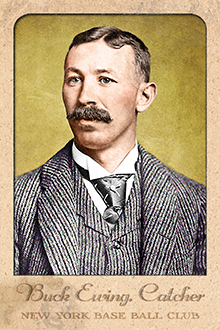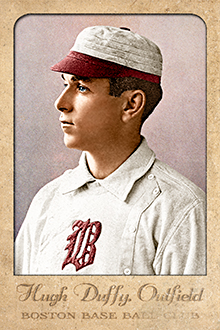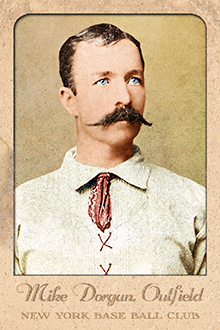
- Series: Pioneer Portraits II: 1875-1899
- City: New York
- Team: Giants
- League: National League
- Hall: National Baseball Hall of Fame
William Ewing (1859-1906) was the premier catcher of the 19th century, honored for decades after his early death as even, perhaps, the greatest player of all time. A scourge at bat, Buck hit over .300 ten times. He played behind the plate with courage and style, crouching close to the hitter so as to shave precious seconds off his inerrant throws. Ewing had debuted with the remarkable Troy Trojans in 1880 and joined four future Hall-of-Famers in moving to NYC in ‘83. The sturdy catcher may have been the primary inspiration for Jim Mutrie’s “my Giants!” exclamation that led to the new identity of the Gothams. An arm injury on a raw spring day curtailed his tenure behind the plate from 1891 on. Such a magnetic figure couldn’t escape the turmoil of the Players’ League controversies and Ewing was sometimes pilloried for lax effort. Despite such caviling, Ewing left as indelible a mark on the game’s first century as anyone. Upon his induction to Cooperstown (among the first six of the “pre-modern” era), he was hailed by Connie Mack as the greatest catcher he had seen and he had seen most.
- “Buck” was a derivative of “Buckingham,” bestowed on the budding star by an admiring scribe who wanted to add gravitas to the youngster’s reputation
- Played all nine positions and managed 3 different teams over 7 seasons
- Was the first catcher elected to the Hall of Fame; and the second 19th century player elected (after Cap Anson)
- Elected to Hall of Fame: 1939

- Series: Pioneer Portraits II: 1875-1899
- City: New York
- Team: Giants
- League: National League
Thomas John Esterbrook (1857-1901) played third and first base for seven different teams over 11 professional seasons. In 1884, Esterbrook had a terrific year, compiling a .314 batting average, with 150 hits, 29 doubles, 11 triples, 110 runs and an OPS+ of 150 for Jim Mutrie’s New York Metropolitans of the American Association. By 1889, Dude was player/manager of the Louisville Colonels during one of the most dismal seasons in MLB history (27-111, the worst record in the AA’s existence). As the losses mounted, tempers rose and Esterbrook’s attempts to fine players met with rebellion. He lost his post to “Chicken” Wolf who replaced him only to face the first true players’ strike when owner Mordecai Davidson reinstated Dude’s levies. Ironically, Esterbrook set his career mark, hitting .318 that woeful campaign, albeit in a part time role. His lifetime average in the majors was .261.
- Esterbrook’s confrontational style, evident in his short tenure as a manager, signalled emotional trouble ahead. His life ended at the age of 43 when he jumped from a train that was transporting him to a psychiatric hospital
- The Dude abides

- Series: Pioneer Portraits II: 1875-1899
- City: Boston
- Team: Beaneaters
- League: National League
- Hall: National Baseball Hall of Fame
Hugh Duffy (1866-1954) is as much a baseball institution as the Hall of Fame that enshrines him. For 68 years he devoted himself to the game he loved and excelled at as few ever have. In 1894 he set the all-time mark with a .440 average while winning the triple crown. He made HOF pitchers look like batting practice coaches: .586 against John Clarkson, .650 vs Cy Young. Amos Rusie was the exception, holding Duffy to a mere .333. So diminutive Cap Anson nearly dismissed him (“We already have a bat boy”), Hugh hustled his way to becoming the only player to hit .300 in four leagues and let the power follow his form (“hit ‘em up the middle”) winning two HR titles. Duffy went on to coach, manage, scout and mentor for a half-century after hanging up his spikes. He was still hitting fungoes eight years after his induction into Cooperstown and delighted in pupil Ted Williams’ success as he sought in vain to eclipse Duffy’s record in 1941.
- Playing career spanned 19 years, primarily in Chicago, Boston and Philadelphia
- Played center field for the Beaneaters next to his “Heavenly Twin,” Tommy McCarthy in right, leading Boston to a pair of pennants
- Elected to Hall of Fame: 1945
- Series: Pioneer Portraits II: 1875-1899
- City: Cleveland
- Team: Blues (NL)
- League: National League
John Henry “Herm” Doscher, Sr. (1852-1934) was a no-nonsense player from 1872-82 and then umpired for three full seasons. He was not above using force to control unruly players. Herm was embroiled in a dispute with management over a contract that led to his temporary ouster from baseball before being exonerated in court and reinstated. He once recalled his days officiating games: “I’ve got to play ring master, school teacher, poppa, momma, and doctor in every game.”
- Doscher’s son Jack became the first second-generation major leaguer in 1903
- As a scout, Herm was credited with discovering Wee Willie Keeler
- Series: Pioneer Portraits II: 1875-1899
- City: New York
- Team: Giants
- League: National League
Michael Cornelius Dorgan (1853-1909) was an outstanding hitter and fielder whose career (and life) was cut short by numerous injuries due to his aggressive play. He starred for the St. Louis Brown Stockings and ended with the Syracuse Stars, his hometown team. Surgery on his knee, hurt making a game-saving catch in 1887, led to blood poisoning and his premature death.
- First Syracuse resident to play in the National League
- Awarded the New York Clipper Gold Badge Award as top defensive player at his position
- Managed parts of 3 seasons for 3 different NL teams from 1879-1881
- Elected to Syracuse Hall of Fame: 1999




